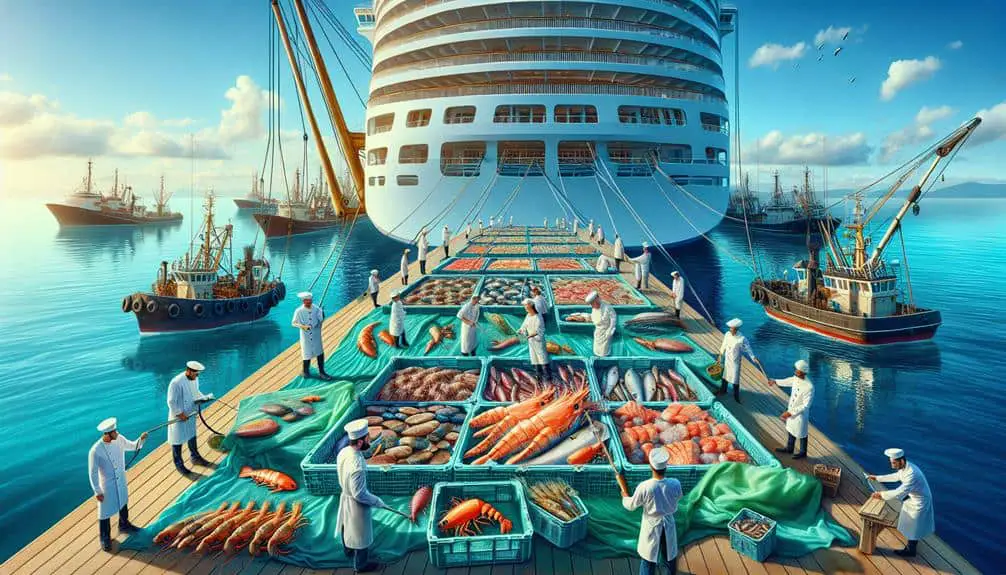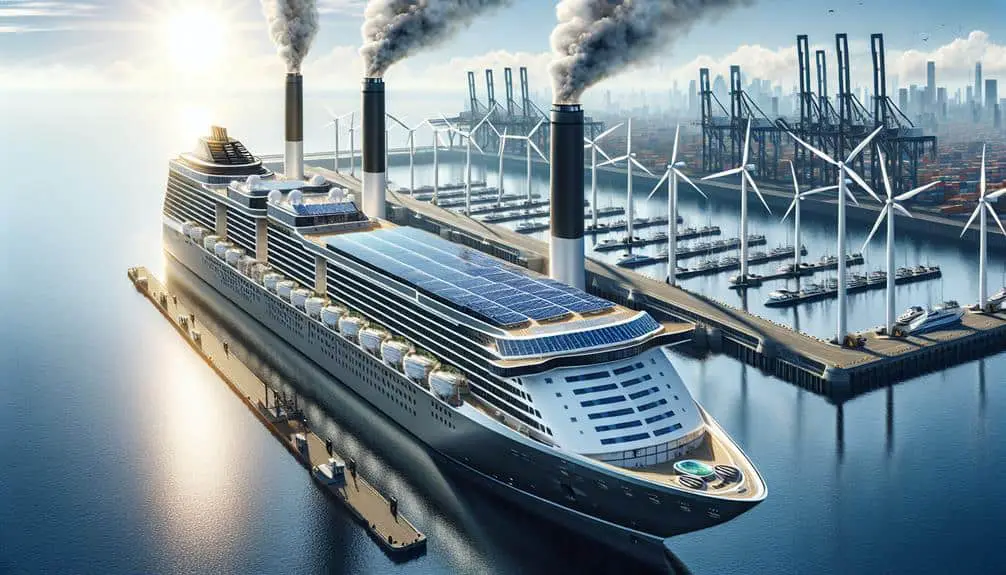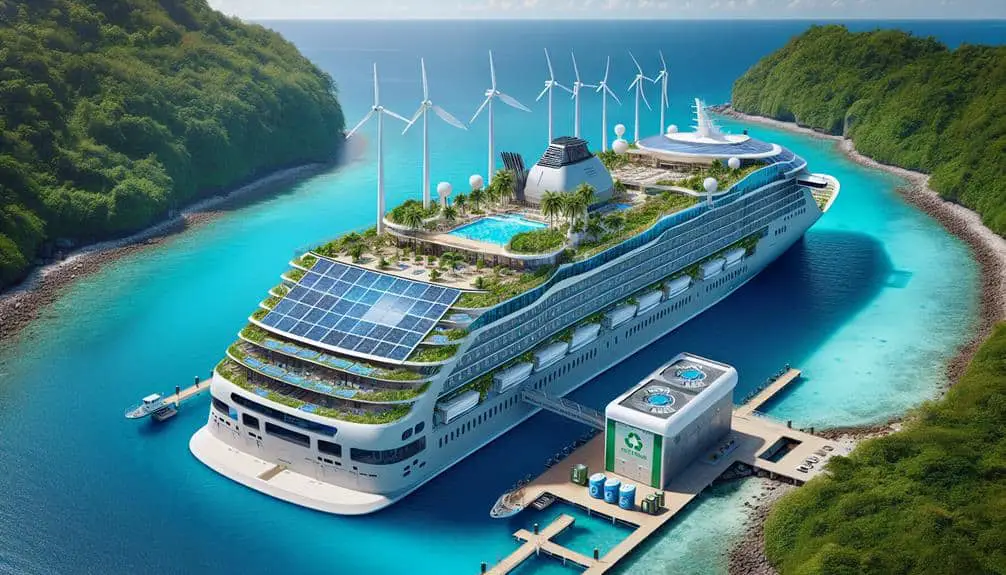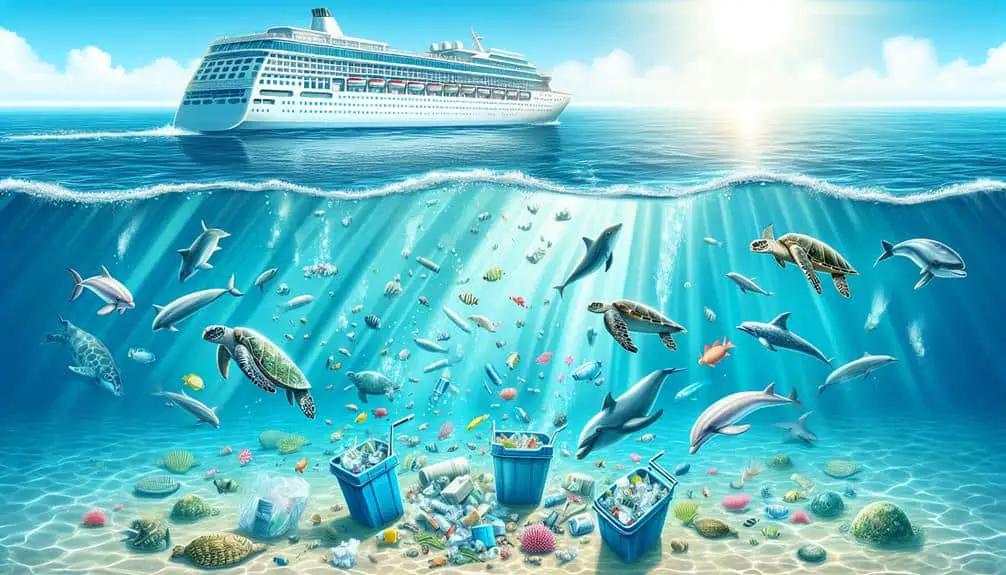To secure sustainable seafood effectively for cruise ships, make sure to select seafood with certifications from MSC or ASC. Choose fishing methods that minimize harm to marine life and check fish stocks status regularly to avoid overexploitation. Collaborate with local fisheries to guarantee responsible sourcing, support coastal communities, and strengthen partnerships. Implement monitoring and traceability systems utilizing data analytics, enhancing supply chain visibility, and investing in technology like blockchain for traceability. Educate passengers on sustainable choices through workshops, consumer awareness, and materials to empower them. Following these steps will aid in securing a healthier ocean ecosystem and marine conservation.
Key Points
- Seek seafood with MSC or ASC certifications for sustainability.
- Choose fishing methods that reduce bycatch and overfishing.
- Ensure transparency in supply chains for traceable sourcing.
- Collaborate with local fisheries for responsible seafood procurement.
- Educate passengers on sustainable seafood choices to promote awareness.
Importance of Sustainable Seafood Sourcing
Sourcing seafood sustainably is crucial for maintaining marine conservation and ensuring the long-term health of ocean ecosystems. By adopting eco-friendly practices in seafood sourcing, cruise ships can play a crucial role in preserving marine biodiversity. Eco-friendly practices encompass a range of strategies, from promoting sustainable fishing methods to reducing bycatch and supporting well-managed fisheries.
Marine conservation hinges on the responsible utilization of seafood resources to prevent overfishing and protect vulnerable species. By prioritizing sustainable seafood options, cruise ships can help alleviate the pressure on fish populations and support the overall health of marine ecosystems. Implementing eco-friendly practices not only safeguards the delicate balance of ocean life but also contributes to the resilience of marine habitats in the face of environmental challenges.
It is imperative for cruise ships to embrace sustainable seafood sourcing practices to mitigate their impact on marine ecosystems. By making informed choices and prioritizing eco-friendly options, cruise ships can become champions of marine conservation and contribute to the long-term health of our oceans.
Criteria for Selecting Sustainable Seafood
When selecting sustainable seafood for cruise ship menus, it's essential to take into account specific criteria to guarantee responsible sourcing practices. Adhering to stringent sourcing standards and understanding the environmental impact of each seafood choice is fundamental.
Here are four key criteria to take into account:
- Certifications: Look for seafood that carries certifications from reputable organizations like the Marine Stewardship Council (MSC) or Aquaculture Stewardship Council (ASC) to ensure sustainable practices are being followed.
- Fishing Methods: Choose seafood caught using methods that minimize bycatch, habitat destruction, and overfishing, such as pole-and-line fishing or aquaculture systems with low environmental impact.
- Stock Status: Check the status of the fish stocks to ensure they aren't overexploited, depleted, or from vulnerable populations by referring to scientific assessments and databases.
- Traceability: Opt for seafood with a transparent supply chain that allows for traceability back to the source, enabling verification of sustainable practices and ensuring accountability.
Collaboration With Local Fisheries
In fostering sustainable seafood practices for cruise ship menus, establishing collaborative partnerships with local fisheries emerges as a pivotal strategy to guarantee the responsible sourcing of seafood products. Local partnerships provide cruise ships with direct access to freshly caught seafood, reducing the carbon footprint associated with long transportation routes. Engaging with local fisheries not only secures the sustainability of seafood stocks but also supports the economic development of coastal communities.
Community engagement initiatives can further strengthen these partnerships by fostering mutual understanding and cooperation. By involving local stakeholders in decision-making processes, cruise ships can create relationships built on trust and transparency. This collaboration can lead to the implementation of sustainable fishing practices that align with both environmental conservation and economic prosperity goals.
Monitoring and Traceability Systems
To guarantee the integrity of sustainable seafood sourcing practices on cruise ships, implementing robust monitoring and traceability systems is essential. These systems assure that seafood is sourced responsibly and ethically, providing passengers with confidence in the seafood served onboard.
Here are four crucial components to contemplate:
- Utilize Data Analytics: Implement advanced data analytics tools to track seafood sourcing information accurately. Analyzing data can help identify trends, potential issues in the supply chain, and areas for improvement.
- Enhance Supply Chain Visibility: Establish a transparent supply chain to trace the journey of seafood from its source to the cruise ship's kitchen. This visibility enables cruise lines to verify sustainable practices at every step of the process.
- Invest in Technology: Embrace technological solutions such as blockchain to enhance traceability and ensure the accuracy of sourcing information. These tools can provide real-time data updates and secure records.
- Regular Auditing: Conduct regular audits of suppliers and fishing practices to ensure compliance with sustainable seafood standards. Audits help maintain the integrity of the sourcing process and identify any deviations that need addressing promptly.
Educating Passengers on Sustainable Choices
Consider educating passengers on sustainable seafood choices by providing interactive onboard workshops and informational materials. Increasing consumer awareness about sustainable practices in seafood sourcing is essential for promoting responsible consumption.
Interactive workshops can include sessions on understanding different seafood certifications, the impact of overfishing on marine ecosystems, and how to make informed choices when selecting seafood options. Providing informational materials such as brochures, posters, and digital displays can further reinforce the message and help passengers make sustainable decisions.
Encouraging passengers to choose sustainably sourced seafood not only benefits the environment but also supports fisheries that prioritize ethical and responsible practices. By educating passengers about the importance of sustainable seafood consumption, cruise ships can play a significant role in promoting conservation efforts.
Additionally, highlighting the benefits of sustainable practices can empower passengers to make conscious choices that contribute to the long-term health of our oceans.
Frequently Asked Questions
Can Cruise Ships Source Sustainable Seafood From Regions Known for Illegal, Unreported, and Unregulated (Iuu) Fishing Practices?
You can't source sustainable seafood from regions with IUU fishing. Guarantee traceability and transparency in sourcing. Market demand drives change. Seek certified suppliers and support sustainable practices. Make informed choices to combat IUU fishing.
How Do Cruise Ships Ensure That Seafood Suppliers Are Not Engaging in Human Rights Violations or Labor Exploitation?
To guarantee labor rights and ethical sourcing compliance, you must prioritize traceability in seafood supply chains. Utilize strict audits, worker interviews, and transparent reporting mechanisms. Engage with suppliers committed to fair labor practices and monitor ongoing compliance rigorously.
Do Cruise Ships Have a Plan in Place to Address Seafood Shortages or Disruptions in Supply Due to Environmental Factors?
To address seafood shortages caused by environmental factors, cruise ships in the sustainable sourcing sector implement contingency plans. Strategies include diversifying suppliers, utilizing alternative seafood sources, and collaborating with experts to mitigate disruptions in the supply chain.
Are There Any Specific Initiatives or Programs in Place to Support Small-Scale and Artisanal Fisheries in the Regions Where Cruise Ships Operate?
Supporting local fishermen through community partnerships is essential for sustainable seafood practices. By engaging with small-scale and artisanal fisheries in cruise ship regions, initiatives can guarantee responsible sourcing, promote economic development, and preserve marine ecosystems.
How Does the Cruise Industry Work With Governmental Bodies and International Organizations to Advocate for Sustainable Fishing Practices and Ocean Conservation Efforts?
To advocate for sustainable fishing practices and ocean conservation, the cruise industry collaborates with governmental bodies and international organizations. By forming partnerships, sharing expertise, and supporting regulations, impactful changes can be made to protect marine ecosystems.




